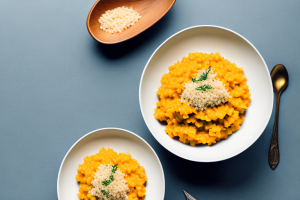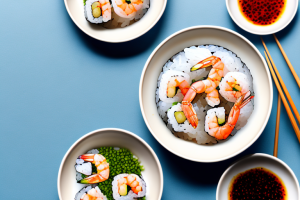How to steam wild rice with roasted root vegetables
9 min read
A bowl of steamed wild rice with roasted root vegetables
When it comes to creating a hearty and healthy meal, wild rice and root vegetables make for a perfect combination. This recipe not only satisfies your taste buds, but it’s also packed with essential nutrients that your body needs. In this article, we’ll take an in-depth look at how to steam wild rice with roasted root vegetables in a delicious and healthy way.
The nutritional benefits of wild rice and root vegetables
Wild rice is a whole grain that’s packed with essential nutrients like fiber, antioxidants, and protein. Not only does it provide your body with energy, but it also improves digestion and reduces the risk of chronic diseases like diabetes and heart disease. Roasted root vegetables, on the other hand, are rich in vitamins and minerals like vitamin A, vitamin C, potassium, and iron. Together, wild rice and root vegetables make for a nutritious meal that meets your dietary needs.
In addition to their nutritional benefits, wild rice and root vegetables are also versatile ingredients that can be used in a variety of dishes. Wild rice can be used in salads, soups, and casseroles, while root vegetables can be roasted, mashed, or used in stews. Incorporating these ingredients into your meals not only adds flavor and texture, but also provides a range of health benefits.
How to choose the best wild rice and root vegetables for your dish
When it comes to wild rice, look for organic and wild-harvested varieties. This ensures that you’re getting the most nutritious and flavorful rice possible. When selecting root vegetables, choose organic ones that are fresh and firm. This ensures that your roasted vegetables are flavorful and cooked evenly during the roasting process.
Another important factor to consider when choosing wild rice is the cooking time. Some varieties of wild rice take longer to cook than others. If you’re short on time, look for quick-cooking wild rice varieties. On the other hand, if you have more time to spare, opt for longer-cooking varieties for a richer and nuttier flavor.
When it comes to root vegetables, don’t be afraid to try new varieties. While carrots and potatoes are popular choices, there are many other delicious options to choose from, such as parsnips, turnips, and rutabagas. Experimenting with different root vegetables can add new flavors and textures to your dish.
Preparing the root vegetables for roasting
When it comes to roasting root vegetables, it’s important to prepare them properly before cooking. First, wash your vegetables and slice them into even sizes. This ensures that they cook evenly and have the perfect texture. Next, coat your vegetables with a thin layer of olive oil, salt, and other seasonings. This enhances the flavor and texture of your veggies while helping them retain moisture during the roasting process. Finally, preheat your oven to 425°F and roast your vegetables for 25-35 minutes until they’re crispy and tender.
Another important tip for preparing root vegetables for roasting is to consider the cooking time of each vegetable. Some vegetables, like carrots and parsnips, take longer to cook than others, like potatoes and beets. To ensure that all of your vegetables are cooked to perfection, you can either roast them separately or add them to the roasting pan at different times, based on their cooking time.
Additionally, you can experiment with different seasonings and herbs to add more flavor to your roasted root vegetables. Some popular options include rosemary, thyme, garlic, and paprika. You can also add a touch of sweetness by drizzling honey or maple syrup over your veggies before roasting them.
The perfect seasoning for roasted root vegetables
Roasted root vegetables go well with a variety of seasonings, but some of the most popular include garlic, rosemary, thyme, and cumin. You can also add a touch of sweetness by adding maple syrup or honey. Experiment with different flavors to find the perfect seasoning for your taste buds.
Another great seasoning option for roasted root vegetables is smoked paprika. This spice adds a smoky, slightly sweet flavor that pairs well with the natural sweetness of the vegetables. Simply toss your chopped root vegetables in olive oil and sprinkle with smoked paprika before roasting in the oven. You can also try adding a squeeze of fresh lemon juice or a sprinkle of Parmesan cheese for an extra burst of flavor.
How to cook wild rice to perfection
Cooking wild rice can be challenging, but it’s worth the effort. To cook wild rice, rinse it thoroughly under cold water and soak it for at least an hour to reduce cooking time. Next, add the rice to a pot of boiling water and reduce the heat to a simmer. Cook the rice for about 40-45 minutes or until it’s tender but not mushy. Drain the water and serve your wild rice hot.
Wild rice is a nutritious and flavorful alternative to traditional white rice. It’s high in protein, fiber, and essential minerals like magnesium and zinc. Additionally, wild rice has a nutty flavor that pairs well with a variety of dishes, from salads to soups.
If you’re looking for a way to add more variety to your meals, try experimenting with different seasonings and ingredients when cooking wild rice. For example, you can add chopped vegetables like carrots, onions, and celery to the pot while the rice is cooking. You can also season the rice with herbs like thyme, rosemary, or sage for added flavor.
Tips for combining wild rice and roasted root vegetables in a dish
When it comes to combining wild rice and roasted root vegetables, the possibilities are endless. You can toss them together in a salad, stuff them in a bell pepper, or serve them as a side dish with your favorite protein. To add even more flavor, consider adding some herbs or nuts like parsley, cilantro, or pine nuts.
Another great way to enjoy wild rice and roasted root vegetables is by making a hearty soup. Simply add some vegetable or chicken broth to a pot with your roasted vegetables and cooked wild rice. Let it simmer for a few minutes and you have a delicious and nutritious soup that is perfect for a cold winter day. You can also experiment with different spices and seasonings to create a unique flavor profile that suits your taste buds.
The benefits of using a steamer for cooking rice and veggies
A steamer is a must-have for healthy and hassle-free meal prep. Steaming vegetables and rice retains the maximum amount of nutrients while keeping them tender and delicious. It’s also an energy-efficient way to cook your food since it requires less water and energy than other cooking methods.
In addition to being a healthy and energy-efficient cooking method, using a steamer also saves time in the kitchen. With a steamer, you can cook rice and vegetables simultaneously, without having to monitor multiple pots on the stove. This means you can spend less time cooking and more time enjoying your meal with family and friends.
How to use a stovetop steamer for perfectly cooked rice and veggies
To use a stovetop steamer for cooking rice and veggies, first, fill the bottom part of your steamer with water and place it on the stovetop. Next, add your rice or veggies to the top colander part of the steamer and cover it with the lid. Turn the heat up to high and let the steam cook your food for about 15-25 minutes, or until your food is tender and cooked throughout.
One important thing to keep in mind when using a stovetop steamer is to make sure that you don’t overfill the colander with food. Overcrowding the colander can prevent the steam from circulating properly, resulting in unevenly cooked food. It’s also important to check the water level in the bottom part of the steamer periodically, and add more water if necessary to prevent it from boiling dry. With these tips in mind, you can use a stovetop steamer to easily and quickly cook delicious and healthy meals.
How to use an electric steamer for easy meal prep
If you don’t want to worry about monitoring your food on the stovetop, an electric steamer is a great option. Simply fill the bottom with water, add your food to the designated compartments, and turn it on. Your food will be cooked evenly and without the need for constant supervision.
One of the benefits of using an electric steamer is that it helps to retain the nutrients in your food. Steaming is a gentle cooking method that doesn’t require any oil or fat, which can help to keep your meals healthy and low in calories. Additionally, because the food is cooked in its own juices, it retains more of its natural flavor and moisture, resulting in a more delicious and satisfying meal.
Meal ideas using steamed wild rice and roasted root vegetables
One great meal idea using steamed wild rice and roasted root vegetables is a Buddha bowl. Simply combine your rice and veggies with some greens, avocado, and your favorite protein. Another idea is to make a wild rice and vegetable pilaf by adding some garlic, shallots, and dried fruit to the mix. You can also make a delicious veggie wrap by filling a whole wheat tortilla with your rice and veggies and adding some hummus or tahini.
Another great way to use steamed wild rice and roasted root vegetables is to make a hearty soup. Simply add your rice and veggies to a pot with some vegetable broth, herbs, and spices, and let it simmer until everything is tender and flavorful. You can also use your rice and veggies as a base for a delicious stir-fry. Just add some protein, like tofu or chicken, and your favorite stir-fry sauce for a quick and easy meal.
If you’re looking for a healthy and satisfying breakfast option, try making a wild rice and vegetable frittata. Simply whisk together some eggs, milk, and your rice and veggies, and bake in the oven until golden and fluffy. You can also use your steamed wild rice and roasted root vegetables as a topping for a savory oatmeal bowl. Just cook your oats with some vegetable broth, and top with your rice and veggies, a fried egg, and some hot sauce for a delicious and filling breakfast.
Variations on the classic recipe: adding herbs, spices, or other ingredients
If you’re looking to switch up your wild rice and roasted root vegetable game, try adding some different herbs, spices, or other ingredients to the mix. Some great ideas include adding feta cheese crumbles, fresh herbs like parsley or cilantro, or even some dried fruits like apricots or cranberries. You can also add some sautéed mushrooms or tofu for some extra protein.
The perfect wine pairing for a meal of wild rice and roasted root vegetables
When it comes to wine pairing with a dish of wild rice and roasted root vegetables, a dry red wine like Pinot Noir or Cabernet Franc pairs perfectly. These wines complement the heartiness of the dish while contrasting its sweetness. If you prefer white wine, go for a Chardonnay or Sauvignon Blanc, which have enough body and acidity to stand up to the flavorful dish.
Recipes incorporating leftover steamed wild rice and roasted root vegetables
If you have some leftover steamed wild rice and roasted root vegetables, don’t let them go to waste. You can use them to make a delicious soup by combining them with some vegetable broth and your favorite seasonings. Another idea is to make a savory breakfast hash by adding some eggs and your favorite breakfast spices. You can also use your leftovers in a stir-fry or a quinoa salad.
Tips for storing and reheating leftover rice and veggies
When it comes to storing and reheating leftover rice and veggies, it’s important to do it properly to avoid foodborne illness. First, let your food cool down completely before placing it in an airtight container. Store your food in the refrigerator for up to three days. You can reheat your food by using a microwave, oven, or stovetop. Make sure to heat your food to a temperature of 165°F before consuming it.
By following these guidelines, you can create a healthy and satisfying meal of steamed wild rice and roasted root vegetables. Whether you opt for a classic recipe or a creative variation, this dish is sure to become a staple in your meal rotation.


